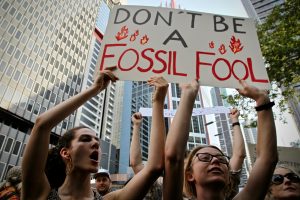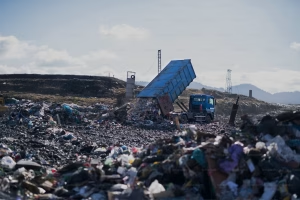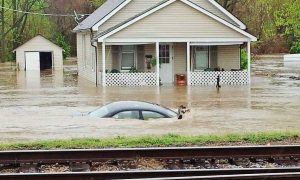

We work alongside low-income and marginalized communities hit hardest by climate change — offering organizing support, free professional services, funding, and space to learn from one another. These frontline communities aren’t just impacted — they’re actively resisting, fighting back with courage, creativity, and a deep understanding of the places they call home.
We have no illusions that our platform is going to turn the tide overnight, but it can prove useful for activists, organizers, and others trying to sort through the multiple proposals and counterproposals swirling around the most momentous issue the world has ever known.
Our 10-Point Platform on Climate Change
1. A phased-in, rapid federal ban on the extraction, refinement, sale, and use of fossil fuels.
Fossil fuels have poisoned our air, land, and water for over two centuries. Today, it’s murderous smog and smoke from oil and coal kill at least 200,000 people per year in the U.S. alone, due to heart disease, cancer, emphysema, and asthma — and millions more worldwide through pollution, war, and climate disasters. As the climate emergency accelerates, the impact is turning genocidal: floods in Bangladesh, droughts in Africa, wildfire and extreme heat in the U.S. and Canada, and the forced migration of hundreds of thousands.

Protestors in Sydney, Australia, hold a sign opposing fossil fuels, 2020, Photo: Kate Ausburn via Unsplash.
The technology to transition to non-carbon-based renewable energy already exists. What’s missing is political will. We must keep coal, oil, and gas in the ground and end the fossil fuel era within 10–15 years, to limit the global temperature-rise to 1.5°C.
Fossil fuel companies — who’ve made trillions while offloading the damage onto the rest of us — should pay for the transition, including support for small businesses and displaced workers in the form of money, retraining, and relocation expenses.
2. Abundant, cheap, clean energy for all.
Everyone deserves access to clean, affordable energy — powered by solar, wind, geothermal, and other renewables. But to get there, we need to break the grip of investor-owned utilities and return energy control to the public: communities, local governments, and everyday people.

A wind turbine installed by Green Cross brings clean energy to East Lubbock, where the volunteer-led group is building a just, resilient future for communities hit hardest by pollution and power outages. Photo: Green Cross
We don’t need massive new grids or endless rows of wind turbines. Rooftop solar with battery storage, neighborhood wind, geothermal, and small solar farms can meet most energy needs. Wherever possible, local microgrids should replace big centralized systems. In areas where that’s not feasible, regional grids can fill the gap. To keep renewables truly sustainable, the materials used to make them should come from recycled sources — not new mining. Clean energy shouldn’t come at the cost of new harm.
3. Energy savings through efficiency and conservation.
Making homes and businesses more efficient is the best ways to reduce greenhouse gas emissions. Better insulation, energy-smart appliances, and electric vehicles will help save money and reduce energy use.
But efficiency alone isn’t enough. Sometimes, using more efficient products actually leads to an increase in energy use overall (known as “Jevon’s Paradox”). For example, if your new car gets better gas mileage than your old one, you are likely to drive it more often. That’s why conservation — actually using less energy — is even more important than efficiency. Riding public transit powered by clean energy, fewer airplane flights, a steep carbon tax (with rebates to low-income individuals), cutting waste, lowering overall consumption, and slashing the massive carbon footprint of the U.S. military, the world’s largest institutional emitter of greenhouse gases, are all critical.
The national and global economic order has undergone many changes in the last several centuries, and it needs to do so again. This challenges the usual push for endless economic growth, but the planet and its people come first. We can make these changes through smart policies like taxing polluting industries, limiting the manufacture or use of climate-hazardous goods, and shifting how we measure progress to include things that truly improve our lives—like art, community, and time spent outdoors.
4. A smaller, simpler economy filled with joy, not junk.
The U.S. is the world’s largest consumer of energy and commodities and its leading polluter. To survive, we need to stop making and consuming so much stuff.

Mountains of discarded waste rise in a landfill, 2022, Photo: Unsplash.
Nature imposes limits, and we’re already using far more resources than the planet can sustain, either by destroying our own land or stealing from others. Renewable energy alone won’t fix this, since fossil fuel use keeps growing to meet rising demand. Since 2009, fossil fuel use has expanded (not declined) to meet growing world demand, while renewables still account for only 11% of global final energy expenditure, up slightly from 9% a decade ago.
So, we have to rethink endless economic growth. Whether you call it “de-growth,” “eco-socialism,” “the ecological state,” or just common sense, slowing down our consumption is essential to avoid catastrophic climate collapse. Nothing is more extreme than letting human civilization disappear.
5. Natural carbon storage.
Forget risky, expensive carbon capture machines — nature already knows how to store carbon. Soils, forests, wetlands, mangroves, and even whales play a huge role in keeping carbon out of the atmosphere.
Better farming practices can keep carbon in the ground and reduce harmful emissions from fertilizers and chemicals. Protecting existing forests, replanting forests that have been cut down, and planting new forests can all increase the absorption of planet-warming CO2. Old- growth forests are important carbon stores and deserve global protection. Logging, thinning, or burning our forests to save them from fires makes no sense.

A member of Iowa Farmers Union — an A2 member — walks his land in the fight for fair, sustainable farming. Photo: Iowa Farmers Union.
Similarly, restoring wetlands, marshes, lakes, and seas can help pull CO2 from the air.
6. Shift to a plant-based food system.
Animal agriculture drives about 15% of global greenhouse gas emissions — especially methane, a super-potent heat-trapping gas. And yet, it gets little attention in climate conversations.
Veganism isn’t only good for protecting animals; it’s good for the earth. Food systems cause one- third of all global greenhouse gas emissions — but they can also be part of the solution. With better farming practices, agriculture can store carbon instead of releasing it.
7. An anti-racist national plan for managing The Great Climate Migration.
Climate change will displace some 30 million Americans over the next half-century. Extreme heat, floods, and fires are already forcing hundreds of thousands of Americans—especially Black, Latinx, and Native peoples—to leave their homes. Black, Latinx, and Native American communities in the U.S. are more likely than white ones to experience these climate exacerbated disasters, but are often the last to receive government support for recovery. Anyone who lives in a floodplain (or near one), or in a region impacted by high heat and wildfires is liable to become a climate migrant.

As floods worsen in De Soto, Missouri, more families face the harsh reality of climate migration. Photo: Citizens’ Committee For Flood Relief
We should create a cabinet-level Department of Climate Migration to support those forced to relocate—bringing together displaced communities and municipalities that have seen their populations decline and economies collapse.
8. The preservation of nature and the protection of animals.
Nature — a space once outside of human control—is under attack. Human-caused climate change has melted ice caps, burned ancient forests, destroyed coral and other oceanic ecosystems, decimated insect and bird populations, and initiated a mass extinction event.

California wildfire devastates the Sierra Nevada mountains, 2021. Photo: Ross Stone via Unsplash.
Until about 10,000 years ago, human cultures were mostly nature-friendly – they took what they needed to live and little more. And even now, amid a capitalist society that disavows its debt to nature, there are Indigenous communities in the U.S., as well as many associations, families, and individuals who hold in their hearts a deeply felt sense of love, protection, and awe for non-human nature. We must follow their lead.
The environmental and climate justice movement has paid too little attention to securing rights for non-human animals. Too often, animals are treated as numbers—species to be preserved, not individuals who suffer. We must reject any policy or project that endangers animals. Our climate solutions must protect all life — human and nonhuman — in order build a safer, more compassionate world.
9. Frontline communities lead.
Frontline communities, and especially ones that are predominantly Black, Latinx, Indigenous, and low-income have experienced the greatest climate impacts and therefore possess the greatest first-hand experience about how to survive and fight back.They must be heard, respected, and directly supported with public and philanthropic funding.

A2 member group Indigenous Peoples of the Coastal Bend demand environmental justice in Corpus Christi, Texas. Photo: Indigenous Peoples of the Coastal Bend.
And lived experience should be paired with science, history, politics, and deep research. That’s why we believe in community science — where residents and researchers work together to understand the problems and build real solutions. Not top-down. Not disconnected.
Wherever possible, federal, state, and local authorities must invest in the tools, training, and support frontline communities need to understand climate-exacerbated disasters, identify the best possible solutions for mitigation, and shape their own future.
10. “Non-reformist reform” or structural change.
We don’t just need quick fixes — we need deep, lasting change. Some solutions ease suffering now but leave the root causes untouched. Others go further, challenging the systems that caused the crisis in the first place, but are unlikely to be embraced by those who wield power and wealth.
We endorse what the Swiss activist and philosopher André Gorz called non-reformist reforms — changes that help in the short term and push us toward structural transformation. For example, building a seawall is a band-aid; restoring wetlands that absorb storm surges is long-term climate justice. Carbon capture and geo-engineering may (or may not) delay the worst, but banning fossil fuels and shifting to renewables attacks the problem at its core.
The best climate solutions ease harm today and make future harm less likely. If a policy or action empowers or emboldens those who are responsible for an irresponsible climate policy—even if it offers short-term benefits—it should be rejected. If it promotes structural change, protects ecosystems and shifts power, it should be embraced.
Here’s what we’re AGAINST:
1. Carbon capture technology – Experimental, expensive, and energy-hungry.
2. Geo-engineeringto reduce global warming – Risky and reckless. Could kill the oceans and allows the petrochemical industry to continue business as usual while profiting from catastrophe.
3. Natural gas (methane) as a “bridge fuel” – Nothing natural about it. It leaks, burns, and worsens climate change.
4. Nuclear power – Dirty to build (burns vast amounts of greenhouse gases), dangerous to manage, and too expensive.
5. Cap-and-trade or a modest carbon tax – These are ruses to allow low carbon businesses to profit from high carbon ones. They have little impact on overall carbon emissions.
6. Hydropower (new dams) – Harm ecosystems, release large amounts of greenhouse gases, and are expensive.
7. So-called “renewable” biofuels with carbon storage – Biofuels such as liquid natural gas (LNG) are not really carbon neutral. They may devastate global agriculture and water reserves.
8. More efficient cows, for example fed with seaweed – Despite attempts to reduce methane emissions and improved feed efficiency, the dairy industry will still pollute, no matter the diet.
9. Carbon offsets by planting trees – A scam. No guarantee trees are planted, maintained, or protected long-term.
10. “De-coupling” economic growth from carbon growth. It’s a nice idea. In practice, it just means exporting carbon-based production from rich countries to poor ones.